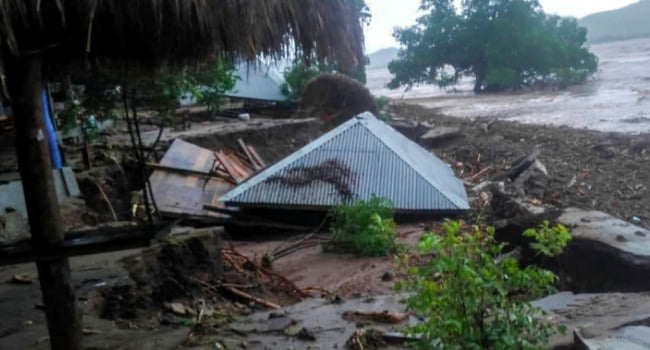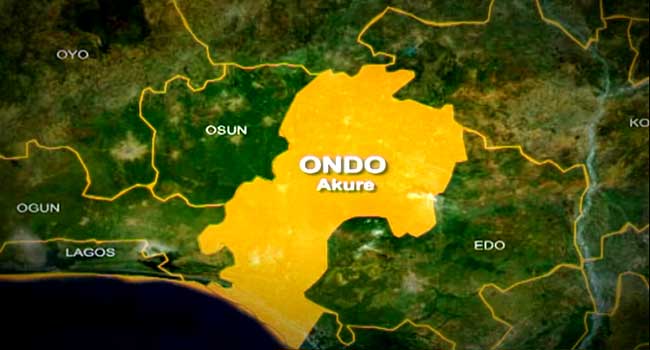Tropical cyclone Seroja pounded Indonesia and East Timor Monday
Packing heavy winds and rain, the storm heaped more misery on the Southeast Asian nations after Sunday’s disaster turned small communities into wastelands of mud and uprooted trees and forced thousands of people into shelters.
Downpours are expected over the next day as the storm triggers offshore waves as high as six metres (20 feet), Indonesia’s disaster agency said.
READ MORE
Portugal on Monday reopened museums, cafe terraces, and secondary schools
The cyclone, which was picking up strength as it moved toward the west coast of Australia, hampered efforts to reach trapped survivors.

HANDOUT / NATIONAL SEARCH AND RESCUE AGENCY / AFP
Indonesia’s disaster agency said at least 70 people have been killed, with another 70 missings.
In East Timor, at least 21 people have been killed according to an official in the tiny half-island nation of 1.3 million that lies between Indonesia and
Australia.
Many of the deaths were in East Timor’s inundated capital Dili, where the front of the presidential palace was transformed into a mud pit.
In Indonesia’s remote East Flores municipality, torrents of mud washed over homes, bridges, and roads.
Images from Indonesia’s search-and-rescue agency showed workers digging up mud-covered corpses before placing them in body bags.
On Lembata, an island east of Flores, parts of some villages were swept down a mountainside and carried to the shore of the ocean.
Soon after flash floods began tearing into resident Basir Langoday’s district in the early morning, he heard screams for help from a nearby home covered in rubble.
“There were four of them inside. Three survived but the other one didn’t make it,” he told reporters.
Langoday and his friends scrambled
to try and save the trapped man before he was crushed to death.
“He said ‘hurry, I can’t hold on any longer,” Langoday added.
Juna Witak, another Lembata resident, joined his family at a local hospital where they wept over the corpse of his mother who was killed in a flash flood Sunday. Her body was found by the seashore.
“There was a rumbling sound and the floods swept away homes, everything,” Witak said.
Medicine, food, blankets’ –
Indonesian President Joko Widodo expressed “deepest condolences” over the devastation in the southeast end of the archipelago.
“I understand the deep sorrow suffered by our brothers and sisters because of this disaster,” he said in a nationwide address.
The European Union said it was ready to offer assistance to poverty-stricken East Timor, officially known as Timor-Leste.
“The catastrophic floods come at a time when Timor-Leste is working hard to contain the spread of Covid-19 among its population, putting a considerable additional strain both on resources and on the Timorese people,” the EU said.
Across the region, residents have flocked to temporary shelters or taken refuge in what was left of their homes.
“The evacuees are spread out. There are hundreds in each sub-district but many others are staying at home,” said Alfons Hada Bethan, head of the East Flores disaster agency.
They need medicine, food, blankets.”
Some 2,500 people had been evacuated in East Timor, along with several thousand more in Indonesia.
READ MORE
Britain will on Monday set out plans to restart international travel, using a “traffic-light”
Pounding rains challenged efforts to find any survivors.
“We suspect many people are buried but it’s not clear how many are missing,” Bethan said.
In Lembata, local officials were forced to deploy heavy equipment to reopen the roads.
Images from the island showed barefoot locals wading through mud and past collapsed houses to evacuate victims on makeshift stretchers.
Fatal landslides and flash floods are common across the Indonesian archipelago during the rainy season.
January saw flash floods hit the Indonesian town of Sumedang in West Java, killing 40 people.
And last September, at least 11 people were killed in landslides on Borneo.
The disaster agency has estimated that 125 million Indonesians — nearly half of the country’s population — live in areas at risk of landslides.
The disasters are often caused by deforestation, according to environmentalists.

